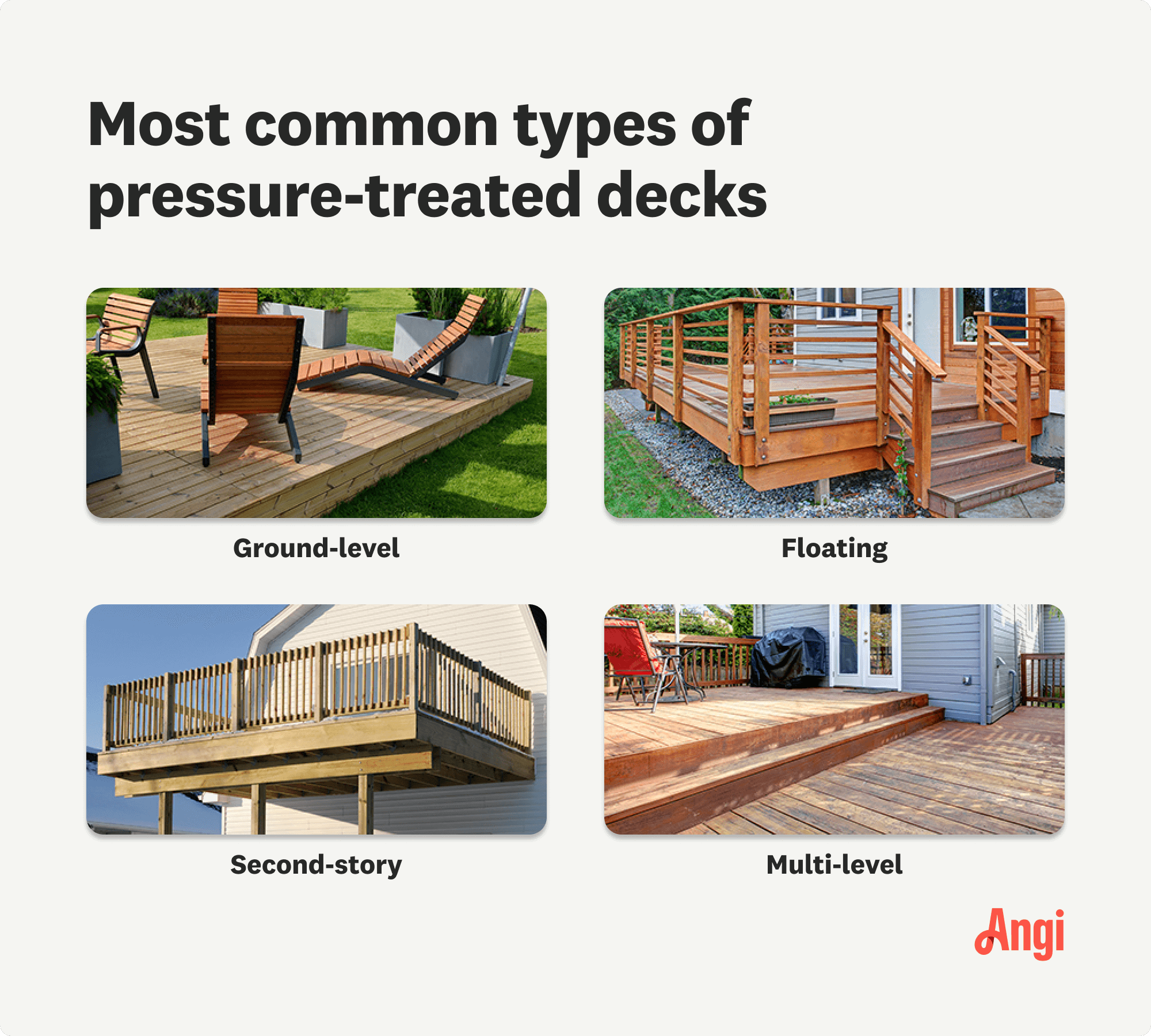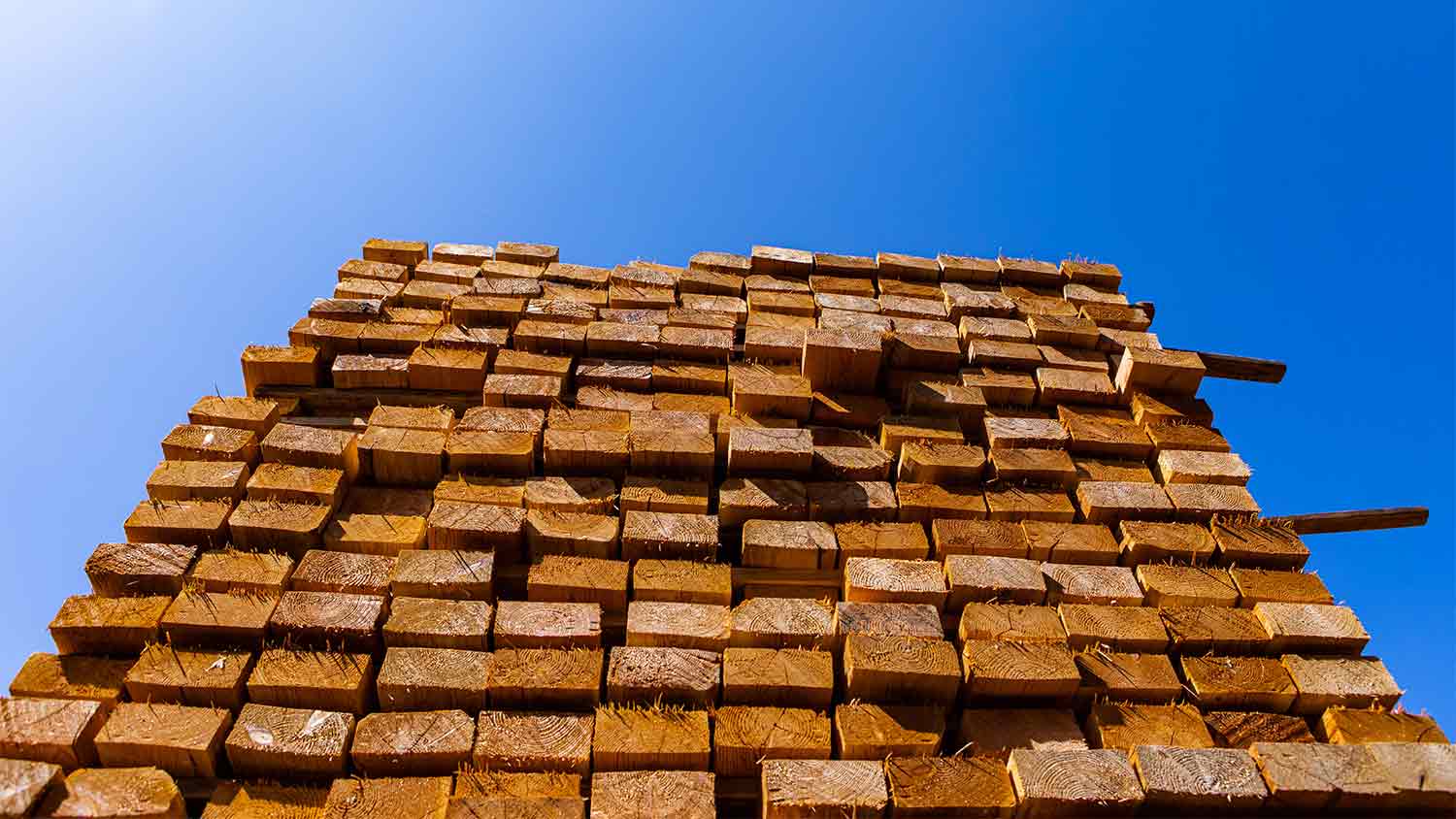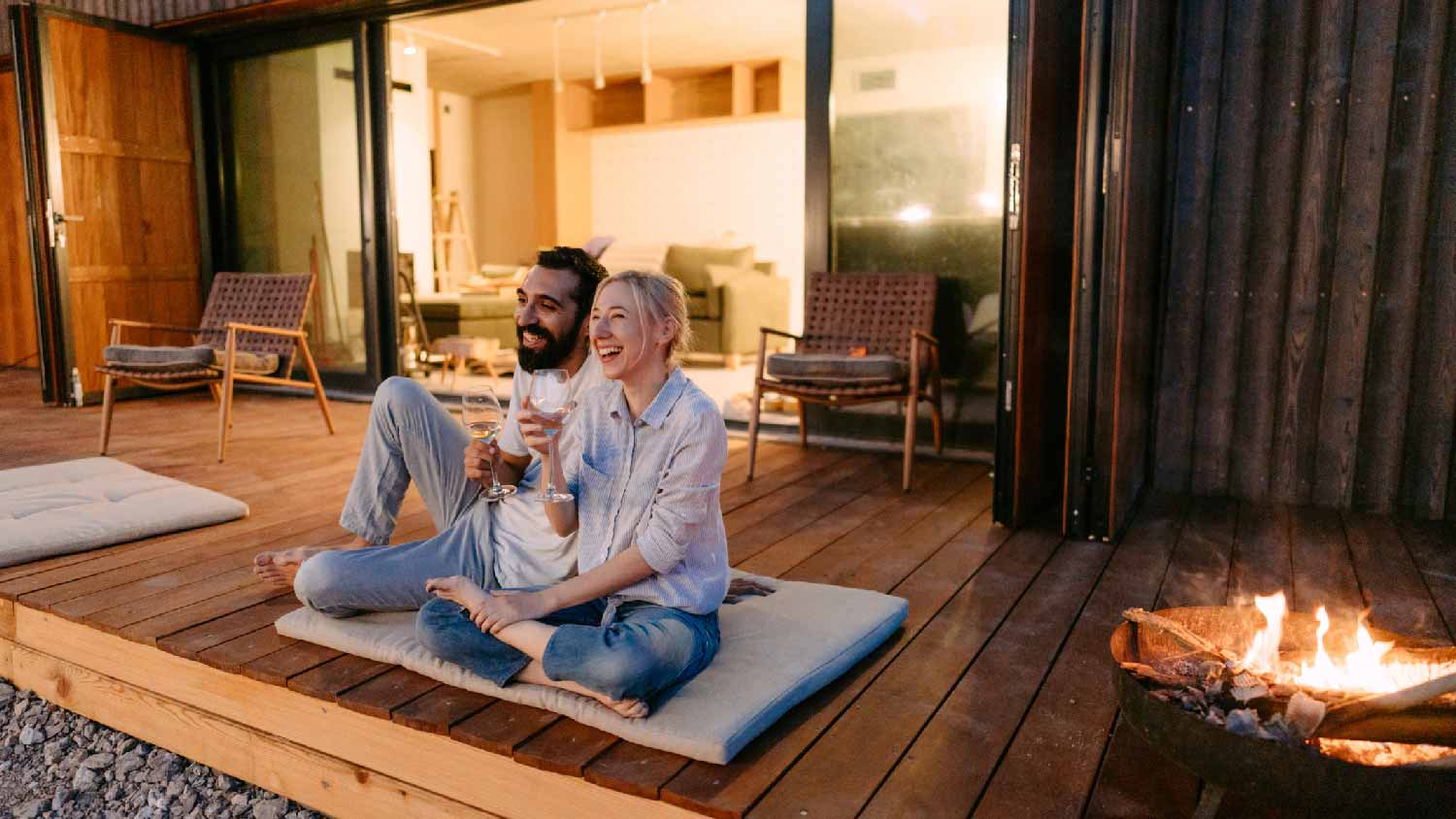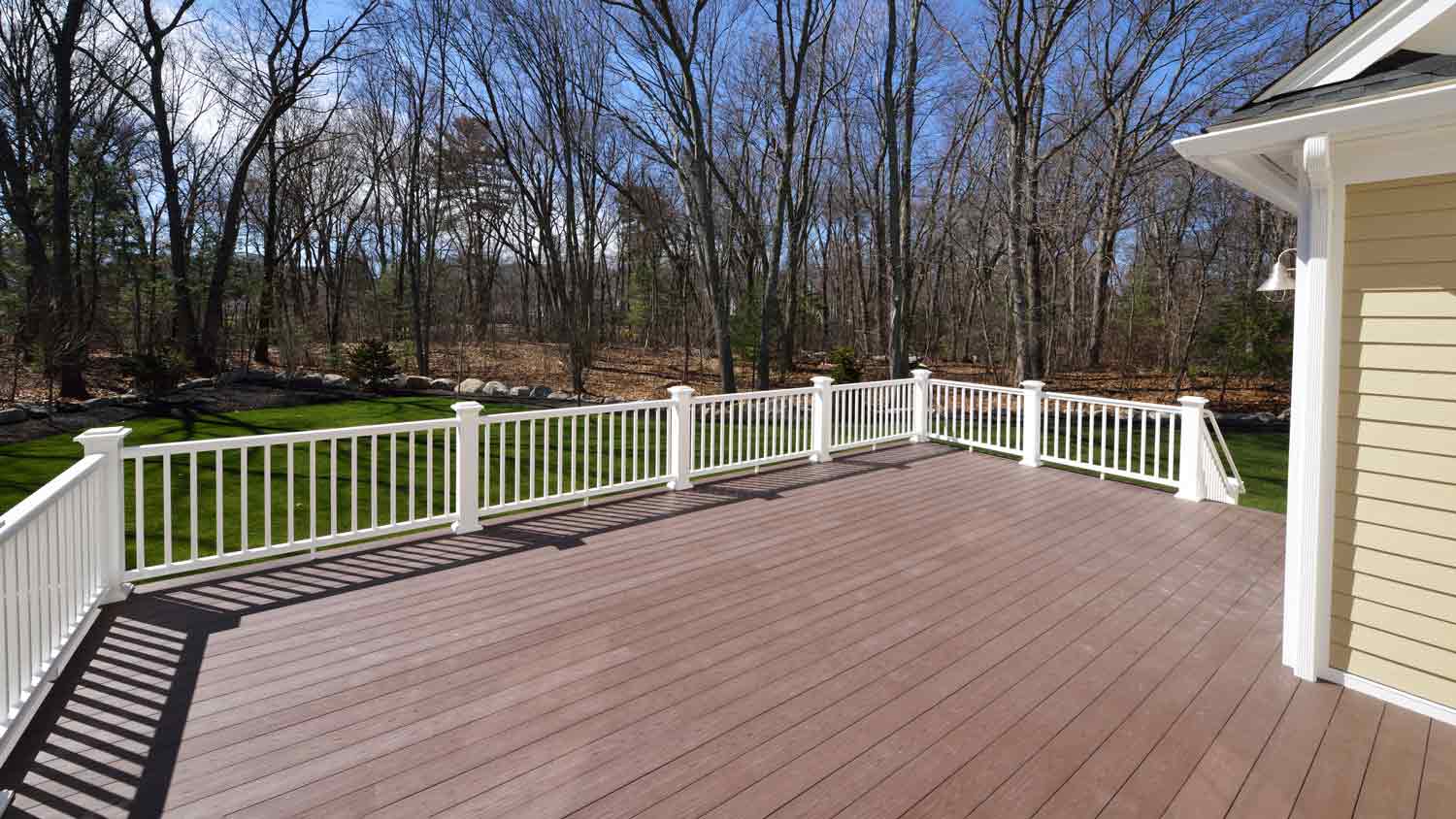
Are your porch columns old or simply unsightly? It might be time to refresh them. Here's a breakdown of the cost of replacing porch columns.
The lifespan of pressure-treated wood can be decades


Pressure-treated wood is wood treated with chemicals to extend its lifetime.
Most pressure-treated lumber is preserved with various alkaline coppers.
With the right care, pressure-treated wood can last up to 40 years.
The main benefits of this material are affordability, durability, and versatility.
Wood offers endless home project opportunities, including building a deck, railings, and planters, but how long does pressure-treated wood last? The outdoor elements can take a toll on wood and make it look less than pristine. Pressure treatment helps protect wood from rot and insects with the help of high pressure and preservatives, helping to extend its life.
Generally, pressure-treated wood can last anywhere from 10 to 40 years, depending on a few factors. Keep reading to learn more about the lifespan of pressure-treated wood and how to extend it as long as possible.
Pressure-treated wood is lumber that has undergone a pressurization treatment to increase durability and prevent decay, mold, insects, and water damage. This treatment utilizes a depressurized holding tank to remove excess air from the wood, and then replaces it with preservatives and water. If you hire a local deck builder to build your dream deck, they will help you choose the best type of pressure-treated wood for your project.
Depending on the application, there are two main types of pressure-treated wood: above-ground lumber and ground-contact lumber. For above-ground projects, you can use basic pressure-treated wood. But for ground-contact projects, like fence posts or landscaping, the wood is pressure-treated with twice the level of chemical retention (and usually with the addition of salt water) to help withstand the extra moisture.
Pressure-treated wood is ideal for projects that may require extra durability or fire retardation, including:
Decks
Framing
Porches
Fences
Railings
Sheds
Garden boxes
Landscape walls
Gazebos or arbors
Swings or playsets
Sandboxes
Pressure-treated wood can last anywhere from 10 to 40 years, according to most manufacturers' guarantees. However, several factors come into play when determining the lifespan of the wood.
Maintenance is crucial for extending the lifespan of the wood. Proper upkeep can keep the wood in good condition for up to four decades. On the other hand, neglecting the wood can reduce its lifespan to an average of nine years.
Regular deck maintenance should include clearing snow and damp leaves to prevent rot, mold, and mildew, trimming grass and hedges, and periodically checking your home's drainage system. Additionally, applying a water repellent six weeks after constructing the wood and annually thereafter can help prolong its life.

The type of wood used is another important factor in determining the lifespan of pressure-treated wood. Pine, cedar, Douglas fir, and hem-fir are the species that best absorb the pressure-treatment chemicals, making them ideal for long-lasting woodwork. Pine and cedar are the most commonly used types of wood for deck framing.
The grade of the lumber is also relevant. #1 grade is a premium grade less likely to warp and has fewer blemishes and knots. It is often used for visible decking and railing projects.
In contrast, #2 or construction grade lumber is rougher looking and is typically used for framing and other non-aesthetic projects. #1 grade lumber is indisputably stronger, but it may need to be special ordered, as most hardware stores stock #2 grade.
Pressure-treated wood in sub-tropical or humid climates has a higher chance of rot due to the moisture in the air and contact with damp vegetation, trees, and shrubs. Therefore, pressure-treated wood in high-humidity areas like Florida should be treated for heavy-duty ground contact to maximize its lifespan.
Wood used in upright construction tends to last longer than wood used in horizontal projects because the upright wood is able to dispel moisture easier. In addition, wood posts that are set into dirt have a shorter lifespan than those set in concrete or gravel.
Despite the various factors that dictate how long your wood will last—and some of them being out of your control—there are a few ways to extend the lifespan of your pressure-treated wood.
Pressure-treated wood takes weeks or months to dry once treated. It’s important to wait out the allotted time before you paint, stain, or seal it. To see if it’s fully dry, sprinkle water onto it. Once the droplets absorb, you can treat or stain the wood deck.
To keep your pressure-treated wood in tip-top condition, you should apply water-repellent sealers every year. And at the first sign of mildew, use a mildewcide cleaner. Together, these steps can help make your wood last longer.
Even pressure-treated wood needs regular maintenance. Remove snow and leaves as they fall to prevent rot and mildew. To help encourage the drying process, you can trim any vegetation away from the wood.
Durable: Pressure-treated wood can withstand all types of damage, including regular use, wear and tear, scratches, and dents.
Rot resistant: The preservatives make the wood resistant to water damage and rot when properly maintained.
Affordable: Wood that is naturally more durable without pressure treatment, like redwood, can come at a higher cost. Pressure treatment allows for the same durability without the same price tag.
Insect resistant: The chemicals used in pressure treatment keep bugs away from your home and wood.
Versatile: Pressure-treated wood can be stained, painted, cut, and combined in various ways.

Historically, countries utilized various compounds and oils to treat and preserve wood, like olive oil in ancient Greece or tar in Rome. Today, most pressure-treated lumber is packed with a combination of various alkaline coppers, like:
ACQ (alkaline copper quaternary)
Copper azole
Micronized copper azole
Copper-HDO
Copper naphthenate
Borate
Polymeric betaine
For commercial uses, oil-type treatments are more common, like creosote or pentachlorophenol. But, these types of treatments usually leave an unpleasant odor or residue, so they’re usually reserved for places that won’t be touched often.
With all these chemicals listed, you may wonder if pressure-treated wood is safe. In the past, companies often pressure-treated wood with a compound called chromated copper arsenate (CCA). But in 2003, the Environmental Protection Agency and the wood industry decided to move away from making CCA-treated wood available for homeowner use because it may pose a health risk.
Today, everything on the market is deemed safe to use in projects like decks, children’s playgrounds, and garden beds.
All DIY projects require safety precautions to prevent damage to you and your home. When working with pressure-treated wood, be sure to:
Wear protective gear, such as gloves, goggles, and masks.
Keep pets, children, food, and water away from the wood.
Always work with pressure-treated wood outdoors to prevent the copper coating from dispersing in your home.
Never burn pressure-treated wood, as the fumes can be harmful to you and the environment.
Use hot-dipped galvanized (HDG) or stainless steel nails, fasteners, bolts, and screws while working with pressure-treated lumber. The copper coating can cause regular hardware to corrode and fail.
Building a pressure-treated wood deck costs anywhere from $4,000 to $12,000, with an average price of $8,000. This cost range fluctuates according to the location of the deck and its size. The quality of the lumber also comes into play here, as does labor. Simple designs, like small ground-level decks, can cost as little as $2,000. On the other hand, complex multi-level decks can cost up to $43,200.
We don’t recommend DIY-ing this project, as it requires expertise in a number of different fields. You have to know how to pour concrete, level footings, install posts, and comply with local building codes. It’s a complex process that’s best left to a local deck builder.
If you do choose to build one of these decks yourself, you’ll save around $4,000 in labor. That’s a big chunk of change, but it could come at the expense of a decreased deck lifespan and an unsafe outdoor space. Only attempt this job if you are skilled in masonry, structural construction, and carpentry.
From average costs to expert advice, get all the answers you need to get your job done.

Are your porch columns old or simply unsightly? It might be time to refresh them. Here's a breakdown of the cost of replacing porch columns.

Flagstone patio costs vary by the size, material type, labor, and more. Stay tuned to see how much your flagstone patio could cost.
Deck repair costs depend on materials, damage you need to fix, and more. See how much it costs to replace or repair a deck in Columbus, OH.

Decks provide usable outdoor space for relaxing and entertaining. But do decks add value to a home? Find out the answer in this informative guide.

Why is my composite deck warping? There are a few key factors at play. Learn more about common problems and how to fix them to get to the bottom of it.

Nothing ruins outdoor ambiance like a greenish deck. Discover why your deck turns green and find some straightforward solutions to fix and prevent the issue.